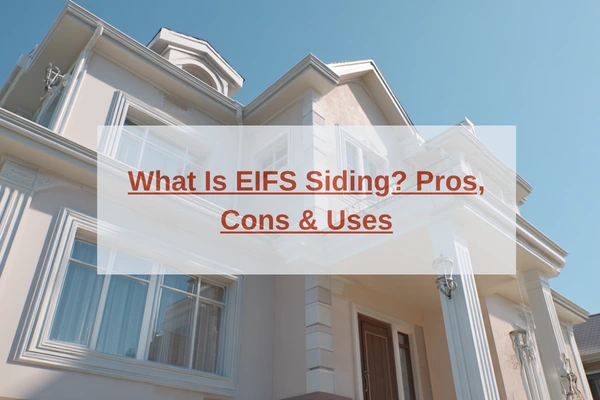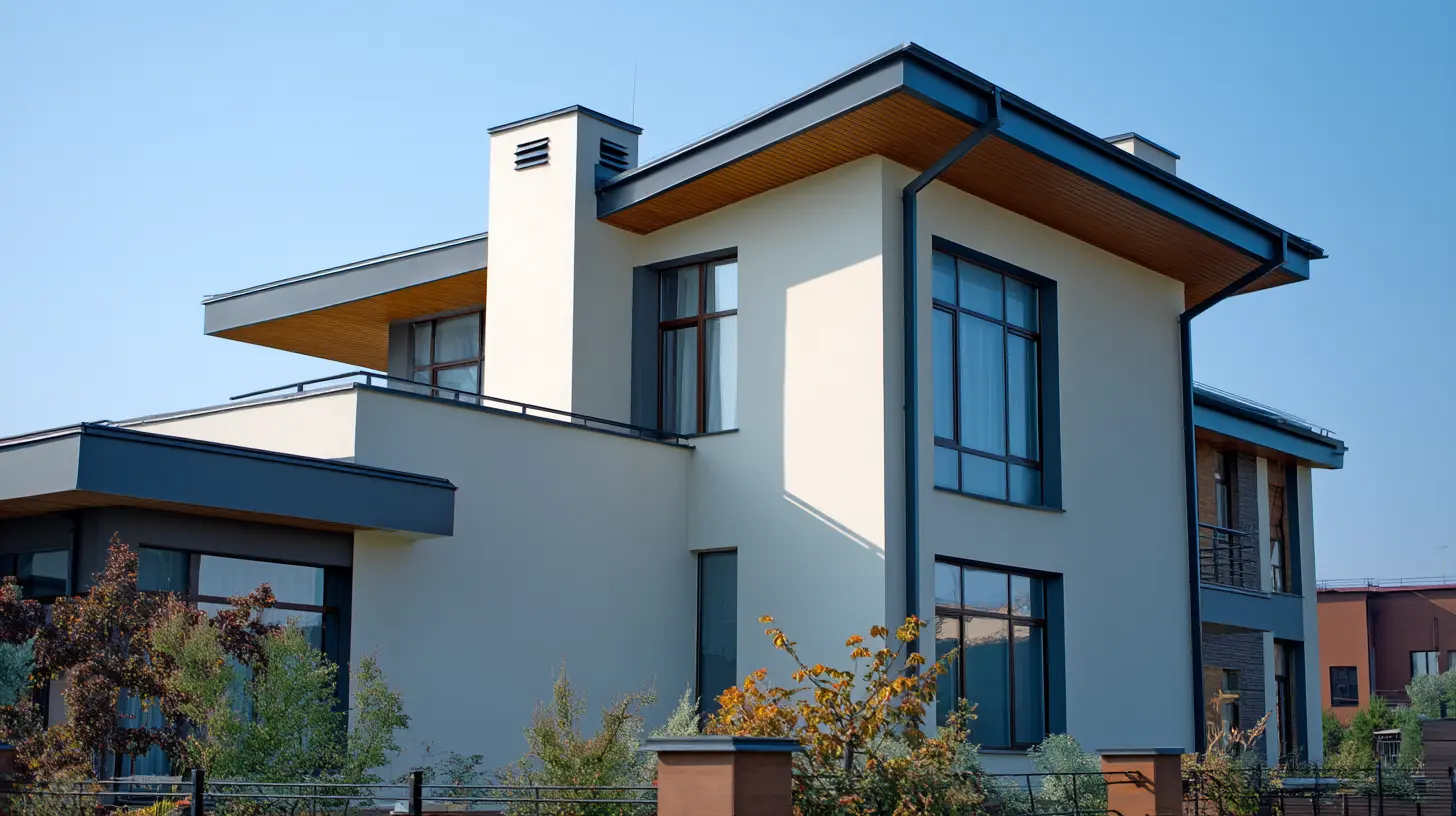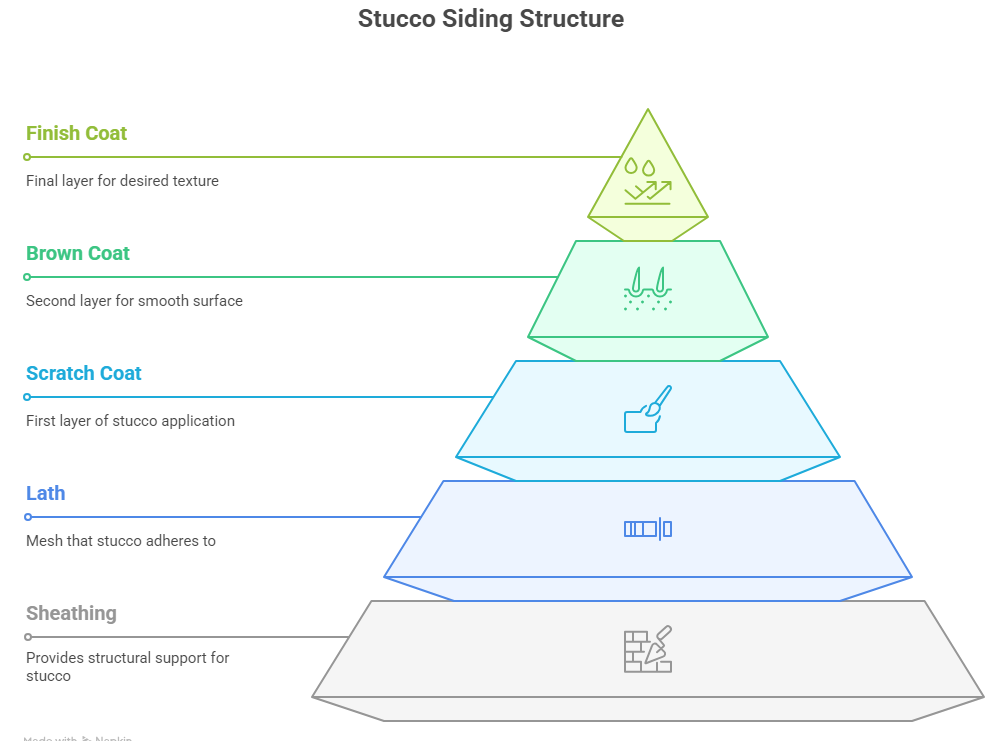
EIFS siding is a widely used exterior cladding system that has been a popular choice for decades in both residential and commercial construction. Despite its prevalence, many are unfamiliar with how it works or whether it’s the best option for a given project.
So, what exactly is EIFS, and how does it compare to traditional materials like stucco? This breakdown covers the pros, cons, and key differences to help inform the decision-making process.
What Is EIFS?
EIFS stands for نظام العزل الخارجي والتشطيبات الخارجية. EIFS is a type of wall cladding system. It's not just a pretty face for your building, though. It’s made up of several layers that work together to provide insulation, weatherproofing, and a finished exterior surface — all in one tidy package.
Think of it like wrapping your building in a warm coat that also looks great. That’s basically what EIFS does. It keeps the heat in during the winter and out during the summer, which can seriously cut down on your energy bills. And on top of that, it comes in a variety of textures and colors, giving architects and designers a lot of creative freedom.
What's EIFS Made Of?
EIFS isn’t just one thing — it’s a system. And like any good system, it works best when all the parts are doing their job. Most modern EIFS setups have six main layers:
1. Water-Resistive Barrier (WRB): This optional first layer goes over the sheathing (the outer surface of your wall structure) to block out moisture before it can do any damage.
2. Drainage Plane: Usually made with vertical adhesive ribbons or grooves, this layer gives any trapped water a way to escape. Very important — no one wants soggy walls.
3. Insulation Board: The heart of the system. Usually made of expanded polystyrene (EPS), this is the foam layer that gives EIFS its impressive energy-saving powers.
4. Reinforcing Mesh: Made of fiberglass, this mesh sits in the base coat and adds strength to the wall surface. Basically, it helps prevent cracking and wear.
5. Base Coat: This is an essential protective layer applied over the insulation layer and mesh fabric. Utilizing a mortar modified with RDP (مسحوق البوليمر القابل لإعادة التشتت), it imparts the coating with outstanding weather resistance, flexibility, crack resistance, and adhesion. The waterproof base layer effectively shields against external erosion, safeguarding the structural integrity of the wall.
6. Finish Coat: The outermost layer, which comes in a wide range of colors and textures. It’s not just for looks — the finish coat is made from acrylics and often includes additives such as HPMC to repel water and resist fading.

Why Use EIFS? - Top 6 Pros of EIFS
If you’re still wondering why someone would choose EIFS over, say, brick or traditional stucco, here’s a breakdown of the biggest benefits:
1. Energy Efficiency
This is the big one. EIFS is well-known for its exceptional thermal performance. It provides continuous insulation across the entire building envelope, which helps eliminate thermal bridging—areas where heat escapes through materials like wood or metal framing. This consistent insulation reduces the load on heating and cooling systems, resulting in lower energy bills and improved indoor comfort year-round.
2. Design Flexibility
Want something sleek and modern? Or maybe a textured, traditional look? With EIFS, it’s all possible. One of the biggest advantages of EIFS is its ability to accommodate a wide variety of architectural styles and finishes. It can mimic stone, wood, stucco, or brick — without the weight or cost. You can even sculpt it into fancy shapes like columns, trim, or detailed accents.
3. Lightweight
EIFS is significantly lighter than traditional cladding materials such as brick, stone, or concrete. This reduces structural stress on the building, making it easier to work with, especially in renovations or additions. The lighter weight also simplifies transportation and installation, which can reduce labor and equipment costs.
4. Durability (If Installed Right)
EIFS is engineered to be flexible and resilient. The synthetic finish coat can expand and contract with the building’s movements, which helps resist cracking that commonly affects traditional stucco. It’s also resistant to fading, chipping, and weather damage, which helps maintain a clean, fresh appearance for many years with minimal maintenance. A common claim is that EIFS has a lifespan of 30 to 60 years.
5. Cost-Effective
Compared to traditional masonry, EIFS is typically more affordable both in terms of material cost and installation time. It can be installed faster and with less specialized labor, and its energy-saving properties contribute to long-term operational cost savings.
Cons of EIFS - 3 Common Problems to Watch For
While there’s a lot to like, EIFS does have some drawbacks you should keep in mind.
1. Moisture Troubles
This is the biggie. If EIFS isn’t sealed and drained properly, water can sneak behind it and get trapped. That can lead to mold, rot, and all sorts of headaches. That’s why good installation is critical. Shortcuts here will come back to bite you.
2. Easily Damaged by Impact
EIFS isn’t bulletproof. A rock kicked up by a lawnmower, or even a baseball, can ding or crack the surface. There are more impact-resistant versions, but standard EIFS is softer than something like brick.
3. Tricky Repairs
If a section of EIFS gets damaged, patching it so it perfectly matches the existing texture and color can be tough. You might need to redo an entire wall to keep it looking uniform.

Where Is EIFS Used?
EIFS (Exterior Insulation and Finish System) is a versatile and energy-efficient cladding system commonly used in the following applications:
- Residential Buildings: EIFS is widely used in residential homes due to its lightweight nature, energy efficiency, and aesthetic flexibility. It helps provide insulation and a variety of design finishes.
- Commercial Buildings: Many commercial buildings, including office buildings, schools, hospitals, and retail centers, use EIFS because it offers excellent thermal performance and can create diverse architectural looks.
- Multifamily Buildings: EIFS is also found in apartment complexes and other multi-unit housing due to its ability to improve energy efficiency and provide a range of textures and colors for exterior finishes.
- Renovations and Retrofits: EIFS is often used in the renovation of older buildings to improve energy efficiency, reduce energy costs, and enhance the building's exterior appearance.
- Climate-Specific Applications: EIFS is popular in regions with extreme weather conditions, such as cold climates, due to its insulation properties. It can help reduce heating and cooling costs and provide moisture resistance when installed properly.
- Architectural Design: EIFS is frequently used in designs that require highly customized, smooth, or textured exteriors. It's ideal for creating intricate architectural details that can mimic stucco, brick, stone, or wood.
[Related reading: RDP في EIFS]

EIFS vs. Traditional Stucco: Not the Same Thing
EIFS stucco is a term sometimes used to describe Exterior Insulation and Finish System (EIFS) because its outer finish resembles traditional stucco. However, EIFS is not the same as traditional stucco—they differ in composition, installation, and performance.
Key Differences Between EIFS and Traditional Stucco
| الميزة | EIFS | Traditional Stucco |
|---|---|---|
| Insulation | Includes rigid foam insulation board (EPS, XPS) | No built-in insulation (requires separate sheathing/insulation) |
| Thickness | Thinner, lightweight (1/8" to 1/4" finish coat) | Thicker, heavier (3/4" to 1" total thickness) |
| Weight | Lightweight | Heavy (needs strong structural support) |
| Flexibility | More flexible, less prone to cracking | Rigid, more prone to cracking over time |
| مقاومة الماء | Can trap moisture if not properly sealed | Breathable, allows moisture to escape |
| Cost | Typically more expensive due to insulation & labor | Usually less expensive but may need added insulation |
Which is Better?
- EIFS is great for energy efficiency and design flexibility, but must be properly waterproofed.
- Traditional stucco is more durable and breathable,e but lacks built-in insulation.

Should You Use EIFS for Your Building?
Here’s the deal: EIFS is a great option if you get it done right. It offers real advantages in energy savings, design possibilities, and durability. But — and this can’t be stressed enough — installation is key. Done poorly, it can turn into a nightmare of moisture issues and costly repairs.
So, EIFS might be a good choice if:
- You want to reduce heating and cooling bills
- You love a modern, clean aesthetic
- You need a lightweight solution for an older building
But maybe not the best pick if:
- You’re in an area where the walls are constantly taking hits or damage
- You’re working with an inexperienced installer.
الأسئلة الشائعة
1. What does EIFS stand for?
EIFS stands for نظام العزل الخارجي والتشطيبات الخارجية. It is a lightweight, multi-layered wall cladding system that provides exterior walls with insulation, weather resistance, and an attractive finish. EIFS is commonly used in both commercial and residential construction for its energy efficiency and design flexibility.
2. Is EIFS cheaper than brick?
There is little price difference. While prices vary depending on location and project specifics, EIFS typically costs $8–$14 per square foot installed, whereas brick can range from $3–$10+ per square foot.
However, brick offers greater durability and lower maintenance over time, while EIFS provides better insulation and design flexibility. The best choice depends on budget, climate, and long-term maintenance preferences.
3. What is the life expectancy of EIFS?
A properly installed and well-maintained EIFS (Exterior Insulation and Finish System) can last 25–40 years or more. Key factors affecting longevity include:
- Installation quality – Poor flashing or sealing can lead to moisture issues.
- Climate – Harsh UV exposure, freeze-thaw cycles, or coastal salt spray may reduce lifespan.
- Maintenance – Regular inspections and prompt repairs (e.g., cracks or sealant failures) are critical.
4. Should I Buy a House With EIFS Stucco?
Yes, but with caution. Buying a house with EIFS (Exterior Insulation and Finish System) stucco can be a good decision if it has been properly installed and maintained. However, there are important risks and considerations you should be aware of.
5. Can You Paint EIFS?
Yes, EIFS can be painted, but it requires the right materials and preparation to ensure long-lasting results.
الخاتمة
EIFS has come a long way from its early days. With better drainage systems and improved materials, it’s now one of the most energy-efficient, versatile exterior finishes out there. Whether you're wrapping a new home, renovating an office building, or just trying to get a unique look without going broke, EIFS is worth considering.
Just remember — like most things in construction, it all comes down to how well it’s installed. Find a pro who knows what they’re doing, and you’ll be good to go.


اترك رد